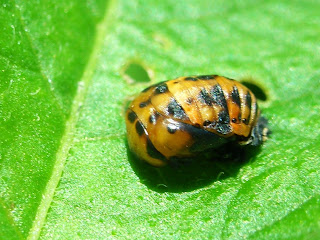Here is the life cycle of the Seven Spotted Lady Beetle, our most numerous species:
 Adult, lays eggs in favorable sites.
Adult, lays eggs in favorable sites. Larva, roams widely, preying primarily on aphids among other things.
Larva, roams widely, preying primarily on aphids among other things. Larva transforms into a pupa, and while attatching itself to a leaf, it does yoga exercises, stretching up to the sun, then down into resting position.
Larva transforms into a pupa, and while attatching itself to a leaf, it does yoga exercises, stretching up to the sun, then down into resting position. The pupa turn from yellow to this color patterning and stay put, about a week, before emerging as adults.
The pupa turn from yellow to this color patterning and stay put, about a week, before emerging as adults.
When pupation is complete, the beetle emerges...
 yellow and tender as a newborn.
yellow and tender as a newborn. They seem to hang around the pupa casing until their shell begins to harden, trying out their newly acquired wings.
They seem to hang around the pupa casing until their shell begins to harden, trying out their newly acquired wings.Just about the time they get their spots and start to turn from yellow to red, they abandon the dried casing, striking out into the garden for food.
 Aphids on a wheat stalk.
Aphids on a wheat stalk.The balance between predator and prey is never static, population densities are always changing, typically following a pattern of alternating boom and bust. In the biological study of ecological communities, it has been observed that when prey populations spike, it will trigger a population explosion of predators, who will typically over-extend the limits of their food resources. Prey species will dwindle, followed by dwindling predator numbers. It's like a game of tag, predator population density seeming to lag behind. As I've mentioned before, it is this lag time that we, as gardeners, must make up for, keeping pest populations under control until the predators can catch up, and either take over for our job, or more typically, complement our efforts to keep pests in balance. And even trickier a gardener must allow enough pest/prey species to survive in order to encourage and support the lagging predators, without letting pests get out of control, damaging the food crops and exponentially exploding in the next generation. It is this balance that I am learning, and observing as I watch the relationship between the aphids and the Lady beetles in my garden.
Recent biology studies into the relationship between predator and prey have revealed some counter-intuitive interactions. The first study I heard (on a radio science show) on this topic, looked into the re-introduction of wolves into parks where they had been locally eradicated for decades. It was thought previously, as it would seem by my description above of the cyclical tag game, that the predators in any given area were a result of the number and type of prey in that area, and that the prey were a result of the availability and abundance of forage. So it was surprising for biologists to discover that it is the predator who largely shapes the landscape, and not the other way around.
To summarize the study, in the absence of predators, the elk and deer had browsed un-harassed, and therefore had selected feed and feeding areas along waterways and streams, to the point where young willows and other trees were grazed down, and stream banks were beginning to erode, and in some places, even dry up. Without predators, the herds grazed the land in different patterns, effecting the landscape and the flora. When the wolves were re-introduced, herds had to return to grazing in open landscapes where they could remain watchful. They shied away from dense clusters of trees, and only approached more exposed waterways where they could stay alert to the ever present danger, minimizing the sites where they entered the water. In a matter of years, the willows regained the stream banks, held the erosion, and kept the waters cool and flowing for the fish and amphibians. Grassland, and meadows started to open again, and clusters of young trees were allowed to grow into forests, supporting the diversity of birds, each of which depend of a specific variance of habitat.
This first study into the impact of wolves on the ecological community from which they had previously been evicted, led to further studies into the impact of predators on the landscape. A study into the impact of spiders on the flora of pastures and meadows revealed the same counter-intuitive result: the presence of spiders changed the feeding habits of insects, which selected for certain plant species that would otherwise be grazed down by herbivorous insects. So perhaps we have the tag-game inverted, and should rather look at it as predators in the lead, with prey species fitting into the spaces where they can best survive, and the landscape as the result of this interaction.
It is interesting to think upon a gardener as a sort of meta-predator in the garden. The landscape, or garden, is the direct result of the gardener's selection of insects and varieties of plants. All other predators are there as guests and allies, dependent on the gardener for prey and habitat. I can see this type of relationship in my garden, never more so than when I hand-pick certain pest species. Patrolling the garden every day for Colorado Potato Beetles and larva, and Imported Cabbage Moth caterpillars, I feel very much like a predator. These are the two pests in my garden that are both visible and can be easily hand-picked, and both can do a lot of damage to foliage if left unchecked. And because I have daily observations of the pest populations, I am also able to observe the populations of predators, which leads me to learn more about enlisting and encouraging the specific predators. This kind of daily observation also teaches me a lot about the life cycles, and seasonal cycles, of these insects (or avian, amphibious and reptilian predators).
I sometimes see my job in the garden as Ecological Wildlife Management. I try to keep things in balance, using a variety of techniques such as row cover and physical barriers, but the most effective techniques are preventative and supportive. (I find the same is true for our own physical health as is true for the garden health.) Prevention techniques revolve around proper rotation, and often require it, for example, in my second year of gardening, I put row cover over a spring crop of radishes to protect from Flea Beetles, but had not managed my rotations correctly. Not yet understanding the life cycle of Flea Beetles, I quickly found that the first generation of Flea Beetles emerged from the soil, under the row cover. I have never yet used an insecticide, and will continue to view it as a last result. Insecticides, including the Organically acceptable plant derivatives, resemble anti-biotics in their inability to distinguish between harmful pests and beneficial insects. And insecticides work against any supportive measures to encourage an intact biosphere of beneficial predators and their prey.
A garden invites intimate interactions with the garden ecology. While reading a 1977 Organic Gardening and Farming magazine, I came across an article written by a woman who understood this intimate relationship. She had been handpicking Hornworm caterpillars from her tomato plants, and stomping them underfoot, when she came across a parasitized caterpillar. She left this one to hatch out the parasitic wasps inside, but was inspired to collect the rest of the caterpillars into a tall bucket. She left the bucket in the garden, and continued to collect and feed the pests. The parasitic wasps had access to an abundance of hosts, and it did not take long before she was hatching out dozens and then hundreds of beneficial wasps.
When I walk through the potato patch and find more Lady beetles and larvae than I can find Colorado Potato beetles, I look at that as the best crop insurance that money can't buy. The toads and Garter snakes have provided the same invaluable crop insurance against slugs in the market garden this year. With 20 inches of rain between June and July, our garden would be overrun with slugs if not for these hungry predators. And I am happy to report that Lady Beetles will continue to find other sources of food when the aphids run short, including the eggs of moths and other beetles, and small invertebrates, which may explain the dramatic reduction in hatching Colorado Potato Beetles since the Lady Beetle population has exploded. I am beginning to find them in the Brassica plot, hoping they will find the Imported Cabbage Moth eggs to be a tasty treat, between the occasional aphid meal.















3 comments:
I love this post and how you explore this not only in your garden but the larger perspective as well. And I love how you brought it back to your own body and your own health as well.
Nature is such a delicate balance and I am so happy to celebrate and contribute to it. Until recently growing my vegetable garden, I struggled with the feeling of consuming without contributing and I'm glad to find that balance that I can add to instead of subtract from.
Thank you for the beautiful blog posting. How important!
Amanda, thanks for your very kind words! I felt similar to you, before I started growing food. It feels good to produce something so unquestionably good and healthy, not just for our own bodies but for our communities and our environment. Keep growing!
This is an awesome post! Since I found your blog again I have been reading it for over an hour now. You are very in tune, it is very refreshing to see. Check your e-mail, peace
Post a Comment